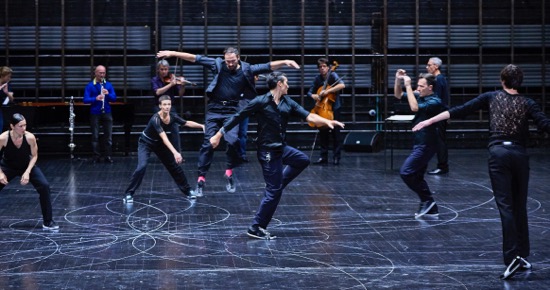
Anne Teresa De Keersmaeker’s Vortex Temporum. Dancers (L to R): Cynthia Loemji, Boštjan Antončič, Michaël Pomero, Julien Monty, and Igor Shyshko. Photo: Robert Altman
Imagine that you’re watching a group of workers assembling a large, complex object. So skillful are they that you can see what they are achieving, although you can’t always tell how they are bringing the object to life. You watch them fascinated—aware that rules, protocols, practices, and relationships govern their every move but not feeling deprived by your lack of knowledge.
This what I experienced while sitting in the Brooklyn Academy of Music’s Howard Gilman Opera House watching two Belgian ensembles, Rosas (dance) and Ictus (music), perform Anne Teresa De Keersmaeker’s Vortex Temporum. The title of the work for seven musicians and seven dancers can be translated as “the whirpool of times.” Afterward, reading the program note and the essays in a book devoted to the work, I understand how intensely De Keersmaeker probed the score by the late Gérard Grisey. Grisey, who died in 1998, was among those composers who called themselves spectralists. Listening to it is the aural equivalent of walking through an intricately layered garden in which a peppering of tiny, ground-covering leaves may precede a cluster of poppies, with a tall goldenrod bursting up over them. Nothing in the music heard during Vox Temporum resembles a strongly articulated rhythm, although a pulse underlies the explosions, ripples, spirals, and pauses of tones. Time suspends itself, circles, and progresses without progression. Or does it?
I can comprehend the program note that tells me that in Vortex Temporum, “Grisey has turned time into something tangible by listening to how sound, as a physical phenomenon, behaves in space, much in the same way air may only be perceived when the wind chases leaves through it.” I can believe that Vortex Temporum grew from a four-note arpeggio in Ravel’s Daphnis and Chloe. But it isn’t easy for me to absorb Grisey’s remark that his 45-minute piece of music was “perhaps only the history of the arpeggio in time and space, below and beyond our frame of auditory perception.” And only on a subliminal level can I appreciate that the conductor of Ictus, Georges-Elie Octors, would like us to think of the work’s three sections as the time of humans, the time of whales, and the time of insects.
In other words, I don’t grasp the compositional details of a score that De Keersmaeker and her co-creating dancers examined note by note. Despite the close onstage collaboration of dancers and musicians, we only rarely see the kind of obvious connection we call “mickey-mousing.” The coincidences are subtler, but equally close in a variety of ways. The choreographer has, for instance, welded dance and music in spatial configurations. The six instrumentalists play the first section alone, seated in a semi-circle and working without music or conductor. Six of the dancers perform the second section in silence and in place. Next, both groups travel in the space together, and finally, the musicians retreat to the back of the stage, use music stands, and follow conductor Octors’ direction, while the dancers expand their use of the territory.
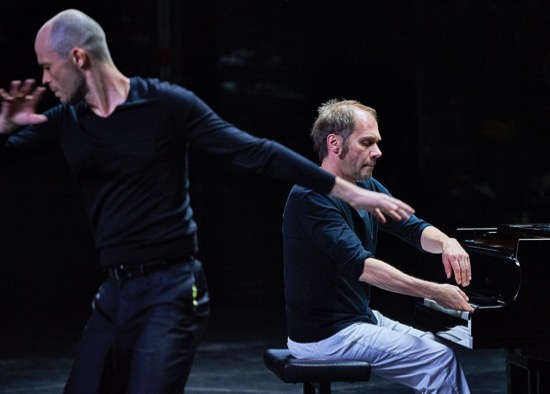
Carlos Garbin and pianist Jean-Luc Plouvier in Anne Teresa De Keersmaeker’s Vortex Temporum. Photo: Robert Altman
In one sense, De Keersmaeker maps this territory for us. When, after the opening section, the musicians exit and the dancers, having removed the chairs, assume the places that the musicians occupied, we’re invited to ponder what binds those in one group to those in the other. Carlos Garbin stands close to the piano that Jean-Luc Plouvier has been playing. Cynthia Loemji replaces flautist Chryssi Dimitriou. Marie Goudot does the same for clarinetist Dirk Descheemaeker. Along the stage left portion of the semi-circle are ranged Bošjan Antončič, Julien Monty, and Michaël Pomero, equated with (respectively) violinist Igor Semenoff, violist Jeroen Robbrecht, and cellist Geert De Bièvre.
The instrumentalists introduce us to more than sounds. Grisey’s music, with its pauses, its rapid scurryings, its eruptions, induces certain performance techniques. At the end of a staccato chord, Plouvier flings a hand off the keyboard in a loose, reactive flourish. Antončič, who sits with his feet planted wide apart, periodically whips his bow off the strings in producing a culminating sound and bends and sways with his violin.
We’re at home for instance, when, in the second section, any of the three dancers affirming his connection to “his” string player repeatedly throws one arm high, as he gradually builds distinctive, in-place movements (his own response to a seminal phrase created by De Keersmaeker). But the men add, diversify, and shift the architecture of what they’re doing. Monty, in the violist’s territory has a lot to do, but they all have moments of going down to the floor, of scooping up air. Sometimes two or more of the three move in unison, sometimes they’re in counterpoint. They may expand their gestures to include a swing of one hip, a change of direction, a kick into the air.
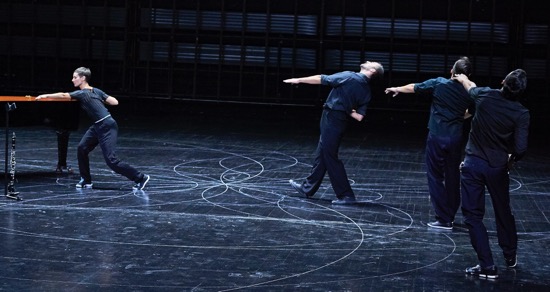
Anne Teresa De Keersmaeker’s Vortex Temporum . (L to R): Marie Goudot, Boštjan Antončič, Julien Monty, and Michaël Pomero. Photo :Robert Altman
During this section, the dancers not moving stand bent sideways, or twisted away from us and leaning at a slant; you can imagine them listening. We may be “seeing” music, but we hear the sound of sneakers against the floor. When it’s Garbin’s turn, he jumps emphatically, his legs bent under him. Much later, he repeats those jumps in response to the music’s percussive chords.
While most of the dancers carry offstage the instruments the musicians have left behind, Garbin performs a remarkable solo—a dodgy one, with busy feet and stiff turns. When Plouvier returns and starts to play, Garbin briefly scrimmages around him on the piano bench and messes with the keyboard before somersaulting away. It’s as if De Keersmaeker wanted to be sure we know that the music-dance correspondence takes many forms. And Garbin’s solo is the counterpart, I think, of Plouvier’s subsequent virtuoso attack on the keyboard. Lord, what music!
The third part of Vox Tempororum (the second part of the music) brings a seventh dancer (Igor Shyshko) into the action; De Keersmaeker, I’ve learned, needed two dancers to bring the pianist’s two hands into the dance. This section revolves—not at first with the intense, down-drawing focus of a real whirlpool, but as a multitude of circles traveled by both dancers and musicians (the photos show them marked on the floor). De Keersemaeker’s relevant drawing in the booklet shows a symmetrical designs of four big interlocking circles surrounding and linking with five smaller ones, within which is a pentagon that can be divided into three triangles (imagine a complicated flower). But the audience doesn’t see symmetry, because of the diverse points at which the performers start traveling in their respective circles and the changing speed of their steps. We see a multiplicity of curves traced by feet walking or running forward or backward, the musicians carrying their instruments. Even the piano gets into the act; Plouvier (amazingly) walks along playing it, while Octors slowly revolves it, causing it to travel around the stage as he does so. Its path spirals out and eventually returns it to its place.
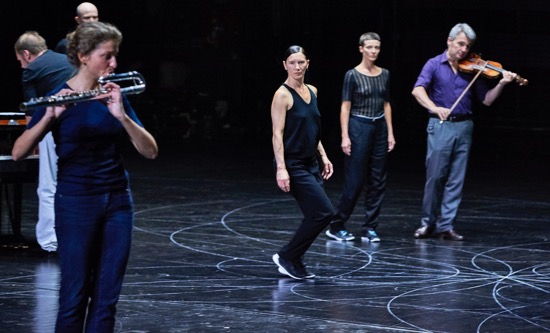
Anne Teresa De Keersmaeker’s Vortex Temporum. (L to R): Chryssi Dimitriou, Cynthia Loemij, Marie Goudot, Igor Semenoff. Visible in the left background: Jean-Luc Plouvier and Carlos Garbin. Photo: Robert Altman
My attempted description may make the scene sound dry, but I didn’t find it so. You watch musicians and dancers collaborating on a pattern that you can’t quite fathom. Yet you grasp the fact that what they are doing has the logic of a well-functioning, peaceful, orderly society, and that you, a virtual anthropologist of sorts, can only gaze upon it and marvel. In the last moments of this section, Plouvier is playing deep, deep notes on the piano, and the stage is growing darker and darker. A sonic whirlpool sucking down the light.
The last section has a different geography and (probably) a different geometry. But with the musicians stationary at the back, the splendid dancers are free to use the whole space of the stage. Surprisingly soft-footed, they gallop, sashay, dip low, fling out a gesture, stop dead, race in counterclockwise circles, spin, school themselves into clumps, take brief rests, start up again. Unison is possible, but mostly they are free agents, spooling out the patterns they have derived from the basic material. Sometimes the musicians play at what seems like impossible speed—wild men riding the score, a cloud of mosquitoes.
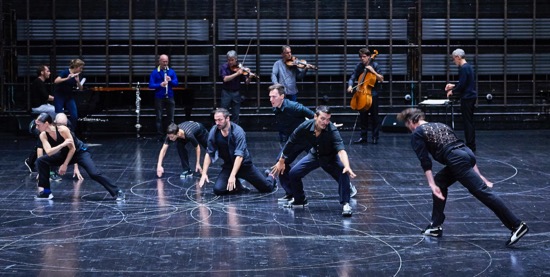
At back, members of Ictus. (L to R): Jean-Luc Plouvier, Chryssi Dimitriou, Dirk Descheemaeker, Igor Semenoff, Jeroen Robbrecht, Geert De Bièvre, Georges-Elie Octors. Members of Rosas (L to R): Cynthia Loemji, Carlos Garbin (hidden), Marie Goudot, Boštjan Antončič, Julien Monty, Michaël Pomero, Igor Shyshko. Photo: Robert Altman
Eventually the piano begins again to emit deep bass notes, and again the lights slowly fade. As the curtain gradually descends you can barely see movement, hardly hear music.
I want to borrow Plouvier’s written words about Vortex Temporum, because they explain this intense and beautiful collaboration between music and dance far better than I can. “We did not become dancers and they did not become musicians and the ambiguous word “gesture” continued to dangle between us like a fertile enigma. As for whether music and dance actually interact, this would be as boring as hell. Let us say that they seek each other out, converge, want from each other, ask for things from each other. As in love, misunderstanding is the norm, nothing happens as planned, and each gives what they do not have.”

A very interesting review of what must have been an extremely interesting performance.